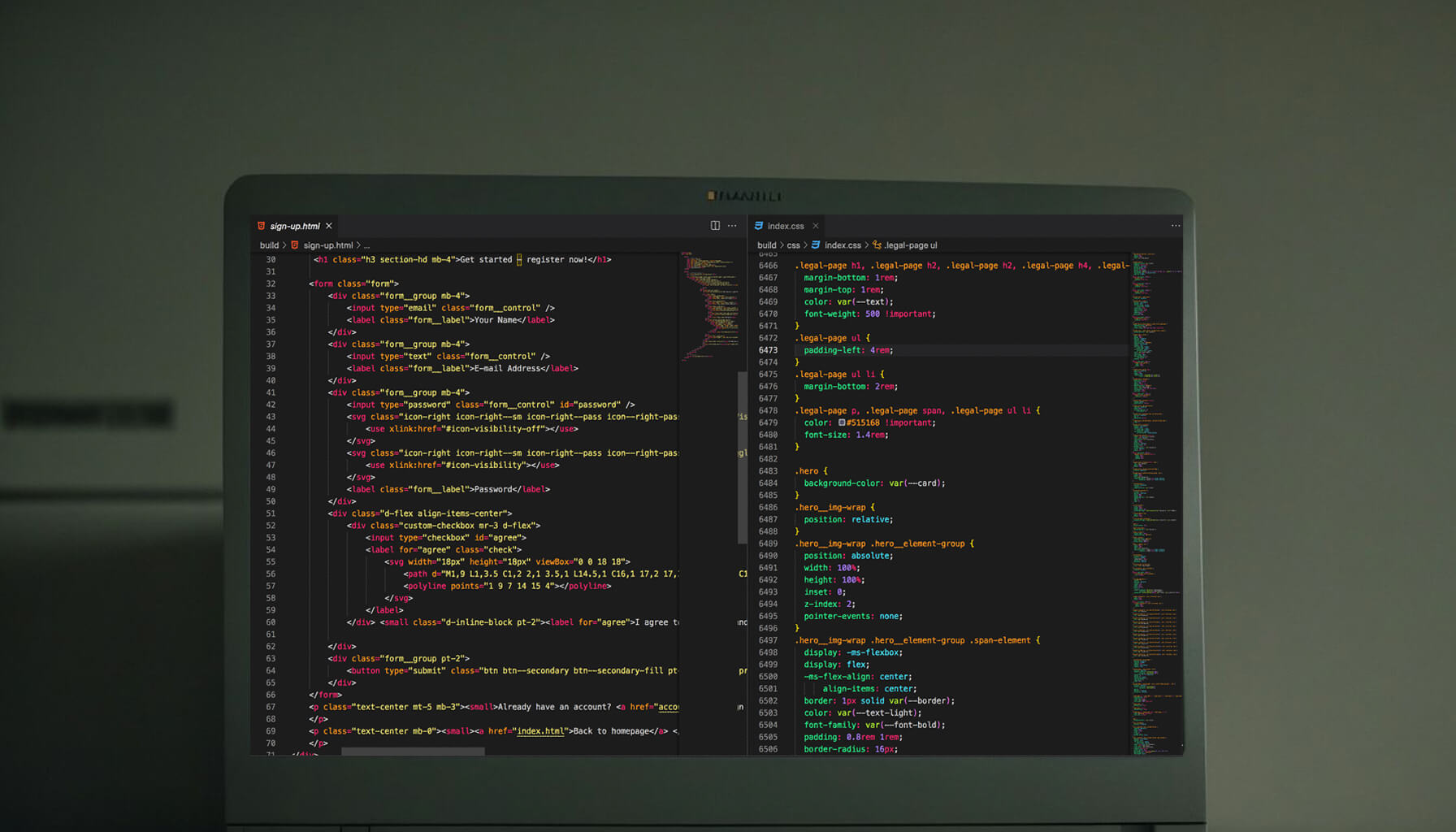Are you curious about coding and where to start? HTML and CSS are the building blocks of web development and a great place to begin your coding journey.
In this article, we will explore the basics of HTML and CSS, including their fundamental concepts and how to write code using these languages. We will also discuss common mistakes to avoid and best practices to follow when writing HTML and CSS.
So, if you’re ready to dive into the world of coding, keep reading to learn more about HTML and CSS!
What Is Coding?
Coding, also known as programming, is the process of creating instructions for computers to execute tasks and operations. It is an essential skill for web development, software creation, and various digital technologies.
Learning to code opens up a world of career opportunities as it is utilized in nearly every industry. With the increasing demand for digital solutions, mastering coding can lead to fulfilling and lucrative career paths.
Beginners have access to various resources like online learning platforms, tutorials, and courses that offer a structured approach to start their coding journey. These resources provide comprehensive learning materials, interactive exercises, and real-world projects, all of which are essential for gaining practical coding skills.
Why Learn HTML and CSS?
Learning HTML and CSS is crucial for aspiring web developers and designers as they form the foundation of front-end web development. HTML provides the structure and content of web pages, while CSS is used to style and design the layout, ensuring a seamless user experience.
Mastering HTML and CSS opens up a world of creative possibilities, allowing individuals to craft visually appealing and responsive web pages. These languages are essential for creating modern websites that adapt to different screen sizes and devices, providing an optimal viewing experience.
Proficiency in HTML and CSS can lead to exciting career opportunities in web design, front-end development, and user experience design. Online courses and resources offer accessible avenues for beginners to grasp the fundamentals of HTML and CSS, paving the way for a fulfilling journey into web development.
What Are the Basic Concepts of HTML and CSS?
The basic concepts of HTML and CSS encompass understanding the syntax, tags, elements, and structure of these languages. HTML involves defining the content and structure of web pages using various tags, while CSS is used for styling, formatting, and creating visual elements such as hyperlinks, images, tables, and forms.
HTML Structure
The structure of HTML involves the use of various tags and elements to organize and present content on web pages. It encompasses creating hyperlinks, embedding images, defining tables, and structuring forms to enhance user interaction.
These tags and elements play a crucial role in structuring the layout and visual appearance of web pages. For instance, the tag is used to create hyperlinks, allowing users to navigate between different web pages or external resources. Similarly, the tag is employed to insert images, enhancing the visual appeal of the content. Tables, defined using the tag, are useful for presenting data in a structured format, making it easier for visitors to comprehend. Forms, created using tags, facilitate user input and data collection, essential for interactive websites.
CSS Styling
CSS styling entails the application of visual attributes to HTML elements, influencing the layout, formatting, and overall design of web pages. It plays a crucial role in shaping the user interface and enhancing the visual appeal of web content.
CSS allows for customization of visual attributes such as dimensions, colors, fonts, and spacing, resulting in a polished appearance. It’s crucial for beginners to understand the fundamentals, including selectors, properties, and values. This provides flexibility in structuring content and adapting it for different screen sizes and devices, promoting responsive design.
For those new to CSS, there are numerous tutorials, online courses, and resources available to help them dive into the world of web design and enhance their skills. As user experience continues to be a top priority, CSS remains highly relevant in web and UI design, making it a valuable skill for aspiring developers and designers.
How to Write HTML and CSS Code?
Writing HTML and CSS code involves creating and structuring web pages using specific tags and elements for content and styling.
Beginners can practice and enhance their skills by working on interactive projects, leveraging templates, and utilizing text editors for coding.
When writing HTML code, it’s essential to understand the purpose and proper utilization of tags such as <div>, <p>, <h1>, <a>, and many others to effectively structure the content.
Similarly, CSS involves styling elements using properties like color, font-size, margin, and more. One useful tip for beginners is to start with simple projects, like creating a basic webpage layout or styling a navigation bar, before advancing to more complex tasks. Engaging in hands-on coding exercises and using pre-designed templates can provide practical experience and reinforce understanding of these fundamental concepts.
Understanding Tags and Elements
Understanding HTML tags and elements is essential for creating well-structured web pages and defining the various components within a browser environment. It forms the basis for practicing and implementing interactive projects and resources.
By familiarizing yourself with HTML tags and elements, you can effectively organize your content, improve accessibility, and enhance user experience.
Beginners can start by practicing the basic structure of HTML and gradually incorporate more advanced elements to develop rich and dynamic web pages. Utilizing online tutorials, code samples, and interactive exercises can help reinforce your understanding and enable you to apply these concepts in real-world scenarios. Engaging in practical projects and seeking feedback from the web development community can further accelerate your mastery of HTML tags and elements.
Using CSS Selectors
CSS selectors enable the targeting and styling of specific HTML elements, providing a powerful mechanism for customizing the visual presentation of web content.
Practicing with selectors on interactive projects and templates helps beginners grasp their functionality and application.
Developers can easily select elements based on their attributes, IDs, classes, and even their position within the HTML structure. This allows for the application of different selectors, including class, ID, attribute, pseudo-class, and pseudo-element selectors, to create unique and visually appealing styles.
Practicing with exercises and experimenting with various selectors is crucial for mastering CSS and customizing web designs and layouts. This, in turn, enhances the overall user experience on websites.
What Are the Common Mistakes in HTML and CSS Coding?
Common mistakes in HTML and CSS coding often revolve around improper use of tags and inconsistent styling practices. These errors can hinder the creation of beginner-friendly and well-structured web content, highlighting the importance of understanding best practices in coding.
Failure to close tags properly and neglecting to apply corresponding opening and closing tags can lead to rendering issues and distorted visual presentation on web pages.
In addition, overlooking semantic HTML and using excessive inline styles can result in cluttered and hard-to-maintain code. Adhering to best practices not only ensures a more organized and accessible codebase but also promotes a cohesive and visually appealing user experience.
Improper Use of Tags
Improper use of HTML tags can lead to structural inconsistencies and content rendering issues, posing challenges for beginners in understanding and implementing best coding practices.
It is crucial to emphasize the correct usage of tags for coherent and well-structured web pages.
Understanding the purpose and proper implementation of HTML tags is vital for maintaining the organization and layout of a web page.
Inappropriate use of tags can disrupt the overall structure, leading to misaligned content, broken formatting, and unpredictable display across different devices and browsers.
Beginners must grasp the significance of employing tags accurately to ensure a seamless user experience and facilitate efficient website maintenance in the long run.
Adhering to best coding practices from the outset can help avoid common mistakes and streamline the development process.
Inconsistent Styling
Inconsistent CSS styling practices can result in disjointed visual elements and erratic layout presentation, affecting the user experience and hindering the adoption of beginner-friendly coding standards.
Emphasizing consistent styling is crucial for maintaining design coherence. CSS styling is crucial in maintaining a consistent and professional visual presentation on a website, resulting in a seamless experience for visitors. By following best practices, even novice developers can establish a solid foundation for visually appealing web design. Consistency in styling promotes user engagement and simplifies navigation, ultimately creating a positive and enjoyable user experience.
What Are the Best Practices for Writing HTML and CSS Code?
Adhering to best practices is essential for writing HTML and CSS code. This includes using semantic elements to enhance content structure and following naming conventions for consistent styling. These practices contribute to the creation of beginner-friendly and well-organized web content.
By utilizing semantic elements, beginners can effectively structure their content, improving its accessibility and search engine optimization.
Adhering to naming conventions ensures a cohesive and maintainable codebase, leading to easier collaboration and future maintenance.
Resources like MDN Web Docs and online tutorials offer in-depth explanations and examples for implementing these best practices, helping beginners grasp their significance and integrate them into their coding workflow.
Use Semantic Elements
Utilizing semantic HTML elements enhances the structural clarity and accessibility of web content, promoting best practices for beginners in creating well-organized and meaningful web pages.
Exploring the significance of semantic elements and their impact on content structure is crucial for newcomers.
It is important for beginners to understand that semantic HTML elements, such as <header>, <nav>, <article>, <section>, and <footer>, play a vital role in organizing content and improving website accessibility.
By using these elements, beginners can ensure that their web pages are properly structured and easily interpreted by both users and search engines. This not only creates a better user experience but also sets a solid foundation for efficient and maintainable coding practices.
To facilitate the understanding and implementation of semantic elements, beginners can benefit from tutorials, guides, and examples available on reputable web development resources like MDN Web Docs, W3Schools, and CSS-Tricks. These resources provide practical insights and demonstrations to empower beginners in leveraging semantic HTML for enriching web content.
Follow CSS Naming Conventions
Adhering to CSS naming conventions fosters consistency in styling practices, facilitating the maintenance and scalability of code for beginners.
Understanding the importance of naming conventions and their impact on styling coherence is crucial for cultivating best practices in CSS coding.
Consistent naming conventions help beginners create styles that are easy to understand and manage. By following a systematic approach to naming classes and IDs, beginners can streamline their code structure and make it more intuitive for others to comprehend.
Regularizing naming conventions ensures clarity and predictability in styling, which is essential for collaborative coding efforts. Utilizing resources like BEM (Block Element Modifier) methodology and other naming conventions guidelines can help beginners grasp and implement these practices effectively.
How to Troubleshoot HTML and CSS Code?
Troubleshooting HTML and CSS code involves utilizing developer tools for identifying and rectifying errors, as well as validating code to ensure compliance with standards.
Engaging in projects and interactive practice enhances beginners’ proficiency in addressing coding issues effectively.
This hands-on approach allows new developers to gain valuable experience in identifying common coding errors, such as incorrect syntax, improper nesting, or CSS specificity conflicts.
By actively participating in projects, beginners can experiment with different techniques and troubleshoot real-world issues, ultimately expanding their problem-solving skills.
It’s essential for novices to familiarize themselves with code validation tools, as these can pinpoint errors and non-compliant code, guiding them towards creating cleaner and more efficient HTML and CSS code.
Using Developer Tools
Leveraging developer tools allows beginners to inspect, debug, and modify HTML and CSS code, facilitating effective troubleshooting and refinement of web content.
Engaging in projects and interactive practice with developer tools enhances the proficiency of beginners in addressing coding challenges.
By utilizing developer tools, individuals can easily identify and rectify errors within their code, leading to improved functionality and user experience.
These tools offer a comprehensive view of the webpage’s structure, styles, and scripts, enabling users to make precise adjustments.
Beginners can benefit from various online tutorials and guides that provide step-by-step instructions on using developer tools for common troubleshooting tasks.
By actively experimenting and learning through these resources, novices can accelerate their understanding and mastery of HTML and CSS.
Validating Code
Validating HTML and CSS code ensures adherence to coding standards and best practices, promoting error-free web content. Engaging in projects and interactive practice with code validation tools facilitates the development of best practices and troubleshooting proficiency for beginners.
For beginners, it’s essential to grasp the importance of clean and consistent code. Validating HTML and CSS ensures compatibility across browsers and devices. This hands-on experience not only improves technical skills but also promotes thoroughness and attention to detail. Participating in projects allows beginners to apply their knowledge in real-world situations, gaining a deeper understanding of the impact of code validation on web development.
What Are the Next Steps After Learning HTML and CSS?
After mastering HTML and CSS, individuals can progress into various paths such as front-end development, back-end development, or pursue full-stack development. Exploring the career opportunities and future prospects in web development provides a clear roadmap for further skill development and professional growth.
Front-end development focuses on creating the visual aspects of websites and applications. This involves using HTML, CSS, and often JavaScript to design user interfaces, responsive layouts, and interactive features.
On the other hand, back-end development involves working on server-side technologies, databases, and APIs. This ensures the functionality and smooth operation of websites. Full-stack development combines both front-end and back-end skills, providing a holistic understanding of web development.
With the increasing demand for web developers, continuous learning through online resources and courses becomes essential. This allows developers to stay updated with the latest technologies and trends in the industry.
Frequently Asked Questions
What is HTML and CSS?
HTML stands for HyperText Markup Language and CSS stands for Cascading Style Sheets. They are two of the most commonly used programming languages for creating and designing websites.
Why is it important to learn HTML and CSS?
HTML and CSS are the foundation of web development and are essential for creating any type of website. Learning these languages will give you the skills and knowledge to create and customize your own website.
Do I need any prior coding experience to learn HTML and CSS?
No, HTML and CSS are considered relatively easy programming languages to learn and do not require any prior coding experience. As long as you have basic computer skills, you can start learning HTML and CSS.
How do I get started with learning HTML and CSS?
There are various online resources and tutorials available to help you learn HTML and CSS. You can also enroll in an online course or attend a coding bootcamp to receive structured learning and support from instructors.
Can HTML and CSS be used for mobile development?
Yes, HTML and CSS can be used to create responsive websites that are optimized for mobile devices. With the rise of mobile usage, it is important for websites to be mobile-friendly, and HTML and CSS can help achieve that.
Is it necessary to learn both HTML and CSS together?
While HTML and CSS are often used together for web development, they are separate languages and can be learned individually. However, it is recommended to learn both as they complement each other and are essential for creating a complete website.






